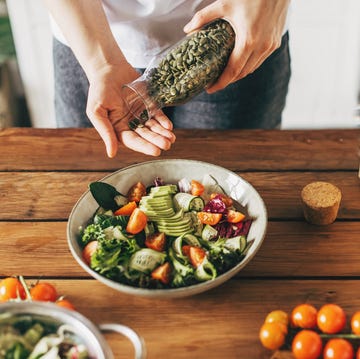10 Foods That Are High in Omega-3 to Support Better Brain and Heart Health
Of course, seafood made the list, but there are other things to eat besides fish.

When it comes to healthy fats, good things come in threes. Omega-3’s! These polyunsaturated fatty acids, or PUFAs, are “good” fats, and as the name implies, there are three main types of omega-3 fatty acids: alpha-linolenic acid (ALA), eicosapentaenoic acid (EPA) and docosahexaenoic acid (DHA).
EPA and DHA, which are prevalent in fish and seafood, are the most bioactive forms of the fatty acid, meaning our bodies use them more efficiently, says Natalie Allen, M.Ed., RDN, LD, a registered dietitian and clinical associate professor at Missouri State University.
Omega-3’s have a ton of health benefits. They can regulate oxidative stress, triglyceride levels, blood pressure, and inflammation. EPA and DHA, in particular, have been found to have protective benefits for the heart and the brain. Omega-3’s may also have benefits for mental health.
“These fatty acids fight against age-related cognitive decline, help make important connections in our neural pathways in the brain and body, and support blood flow to the brain,” says Sue-Ellen Anderson-Haynes, MS, RDN, CDCES, a registered dietitian and spokesperson for the Academy of Nutrition and Dietetics.
There is no official Recommended Daily Allowance (RDA) for omega-3, but the general recommendation is at least 250 to 500 milligrams of combined EPA and DHA per day for healthy adults. The recommendation for ALA per day is 1.6 grams for men and 1.1 grams per day for women.
Omega-3’s are essential fatty acids, meaning the body can’t produce them on its own, so we need to get them through food. That's where this list comes in: These are the foods highest in Omega-3 fatty acids.
If you don’t eat fish, an omega-3 supplement might be a good idea. (Check with your healthcare provider first to make sure it’s safe for you, and as with any supplement, mind the dosage.)

Kristen F. Gradney, M.H.A., R.D.N., L.D.N. is a registered dietitian nutritionist and healthcare administrator in Baton Rouge, LA. As Senior Director of Operations at Our Lady of the Lake Regional Medical Center, she supports health equity and holistic healthcare in schools, community, and medical practices. She also owns Tableau Consulting Services, LLC. and has been featured in many publications as expert on many topics including nutrition, wellness, and health equity. She strives to create culturally relevant, systematic changes that improve healthcare of individuals and communities. Gradney obtained a B.A. in Sociology in 2001, and a B.S. in Nutritional Science, in 2007, from Louisiana State University. She then completed a dietetic internship at the Medical University of South Carolina, Charleston, South Carolina, and has worked as a registered dietitian in areas of inpatient and ambulatory care, culinary medicine, transplant, and pediatric wellness. In 2016, she obtained a Master of Health Administration from Our Lady of the Lake College in Baton Rouge.


But Wait, Are Sardines Actually Healthy?

Is Rotisserie Chicken Healthy?

What Happened When I Went 2 Weeks Without Meat

These Vegetables Are Surprisingly High In Vitamin C

















